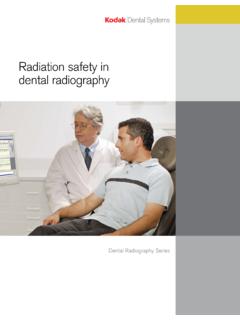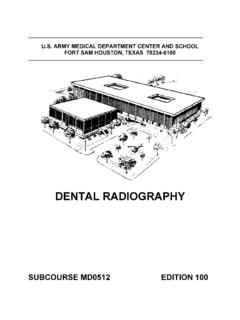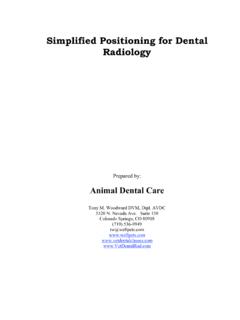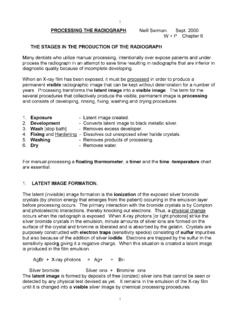Transcription of Review of: Dental Radiography: Principles and Techniques
1 Source: Journal of Dental Hygiene, Vol. 80, No. 3, July 2006 Copyright by The American Dental Hygienists' AssociationReview of: Dental radiography : Principles and TechniquesJacqueline Brian, LDH, MSEdReviewed by Jacqueline Brian, LDH, MSEd, professor, Indiana University-Purdue University Fort Wayne, Fort Wayne, radiography : Principles and TechniquesThird EditionHaring JI and Howerton LJW. B. Saunders Company, 2006St. Louis, Missouri544 pages; illustrated; indexed; softcoverISBN: 0-72161-575-9$ third edition of Dental Radiology: Principles and Techniques has quickly become the premier resource forcomprehensive-yet clear and concise-fundamental concepts of Dental radiology. The authors have wrapped these positivelearning features into short chapters to facilitate student learning and ease in text is divided into 6 parts: Radiation; Equipment, Film and Processing; Dental Radiographer; Technique; NormalAnatomy and Film Mounting; and Radiographic concepts are difficult to master, so the step-by-step procedures for proper Techniques , which include rationalesand charting notes, allow students to easily gain a solid understanding of these procedures.
2 Other learning-friendly featuresare the quiz questions for each chapter and example 1 -In addition, 750 strategically placed, detailed illustrations are combined with a clear writing style to explain concepts ina simple, student-friendly way. These tools are essential for the comprehension of critical materialThe authors also recognized the need for students to play an active role in their own learning, and thus have expertlyexpanded beyond the basic teaching medium. They've included a companion, interactive CD-ROM, a new Web site, whichincludes a 110-question self-study exam, as well as a series of patient case studies that are in the same format as theNational Board Dental Hygiene Exam. Animations also help the students visualize and learn key concepts and theoriesthat are so difficult to these learning tools are important to link the essential information to the application for development of self-directedstudent learning.
3 In updating this new text, the authors have included the latest advances in radiography , including additionalchapters on Descriptive Terminology and Interpretation of Restorations and Dental Materials. This additional materialwill better prepare students for future National Board Dental Hygiene beyond student needs, the authors have provided instructors with a new, online resource manual that will saveclass preparation time. This will be a valuable course management tool for instructors who may be unfamiliar with thissubject leaders in their field, the authors have provided an impressive resource for Dental hygiene and Dental assisting instructors will want to include this text as required of Dental Hygiene, Vol. 80, No. 3, July 2006 Copyright by The American Dental Hygienists' Association- 2 -Source: Journal of Dental Hygiene, Vol.
4 80, No. 3, July 2006 Copyright by the American Dental Hygienists' AssociationReview of: Practical Oral MedicineRuth Fearing Tornwall, RDH, MSReviewed by Ruth Fearing Tornwall, RDH, MS, Instructor IV at Lamar Institute of Technology in Beaumont, Oral MedicineFirst EditionMacleod I and Crighton AQuintessence Publishing Co., Ltd., 2006 London, England164 pages, color illustrations, indexed, hardcoverISBN: 1850970653$ Oral Medicine is a new book in the Quintessentials for the General Dental Practice series from book, like others in this series, is concise, easy-to-absorb, and up-to-date with color illustrations. The book is meantto be an easy to understand chairside reference text, providing oral medicine information and advice. The level of writingis appropriate for Dental health book includes 11 chapters, with the first being an introductory chapter and the last covering therapies in oral chapter includes an aim, outcome, introduction to the area, the lesion or condition being discussed, diagnosis,management or treatment, a conclusion or summary, and references for further 1 -The introductory chapter describes in detail the procedure for an oral medicine consultation.
5 The authors stress the factthat this meeting sets the tone for all remaining visits. The consultation includes the greeting, the purpose of the appointment,the information gathering format, a Review and discussion of the key points of the examination, the conclusion of thefindings, and the discussion of any future appointments, if necessary. At the end of this meeting, both the patient and thepractitioner should have a clear understanding of their future care 2 reviews immunological problems, including the oral effects of allergy along with the oral mucosal effects ofimmunological reactions to the oral mucosa. Chapter 3 examines the various oral and perioral lumps and swellings, theirdiagnosis, and management. The authors conclude that these lesions are a common finding with most being though, many of these lesions are similar and need to be differentiated histologically.
6 The authors state thereare some instances when a lesion would warrant further 4 looks at common oral mucosal and facial infections. The authors break down the infections into categories ofbacterial, viral, and fungal lesions. The main principle in treating these lesions is to identify the active organism anddetermine its sensitivity to antimicrobial therapy. Chapter 5 covers white patches, dividing them into 2 groups, those thatcan rub off and those that cannot. Chapter 6 describes the diagnosis and management of oral cancer and premalignantlesions; risk factors and possible risk factors are identified in the chapter. The authors suggest Dental health professionalsshould be able to council patients about risk factors, as surviving oral cancer depends on its early 7 describes various disorders that can result in pigmentation of the oral mucosa.
7 Chapter 8 examines variousdisorders that can affect the salivary glands and salivation. The chapter is divided into 3 categories: salivary flow disturbance,salivary gland infections, and salivary gland swellings. Most problems are a relatively common occurrence but all complaintswarrant investigation. Chapter 9 covers facial pain. The chapter seeks to make the clinical pattern of different pain problemsmore familiar. The authors emphasize the importance of taking a careful history and highlight using quality of life as ameasure of success. Chapter 10 reviews the common neurological problems that may occur in the head, neck, and 11 describes the range and value of the various complementary therapies that may be used in oral medicine. Theyconclude that the evidence base for many therapies is lacking and further research is needed in these book contains an index as well as 2 appendices.
8 The index includes most of the major headings and many terms usedwithin the chapters. Appendix A reviews the features of 6 common oral medicine conditions and their protocols that shouldbe used in conjunction with the general history and examination guidelines as suggested in Chapter 1. Each protocolconcentrates on the more detailed history or examination that is needed when considering each diagnosis. These conditionsinclude lichen planus, recurrent oral ulcerations, white patches, sore lips-cheilitis and angular stomatisis-oral dysaesthesia,and temporomandibular disorders. Appendix B lists topical and systemic steroid treatment the book succeeds in its goal to provide the reader with a succinct easy-to-use text on oral medicine. One area thatcould have been improved upon is the number of photos in the book to illustrate the lesion under discussion; but, the photosthat are there are of high quality.
9 This is a book that could easily fit into one's oral health of Dental Hygiene, Vol. 80, No. 3, July 2006 Copyright by the American Dental Hygienists' Association- 2 -Source: Journal of Dental Hygiene, Vol. 80, No. 3, July 2006 Copyright by The American Dental Hygienists' AssociationReview of: Pocket Atlas of Oral DiseasesMargaret Six, RDH, MSDHR eviewed by Margaret Six, RDH, MSDH, associate professor at West Liberty State College, West Liberty, West Atlas of Oral Diseases2nd Pocket EditionLaskaris G, MD, DDS, PhDThieme Medical Publishers, 2006 New York, New York384 pages, softcover, indexed, illustratedISBN: 1588902498$ Atlas of Oral Diseases is an excellent reference text for the Dental professional. The second pocket edition, writtenby George Laskaris, MD, DDS, PhD, consists of 370 pages filled with 350 color photographs, with associated literatureto describe conditions and diseases found in the oral cavity.
10 Laskaris offers a comprehensive overview of local and systemicoral disease in a pocket-size book. The small size lends itself to easy storage in a lab coat pocket or the smallest space ina busy Dental operatory for quick 1 -The contents of the text are well organized into 12 chapters. Three chapters are devoted to lesions categorized by the colorswhite, red, brown, and black, which assist the reader in quickly locating a photograph with associated facts particular tothe lesion. Additional chapters include the categories of ulcerative, vesiculobullous, papillary, and lip lesions. The remainingchapters include soft tissue tumors and cysts, bone and neck swellings, and gingival each chapter, the definition, etiology, clinical features, laboratory test, differential diagnosis, and treatment guidelinesfor each oral disease or condition is described.










